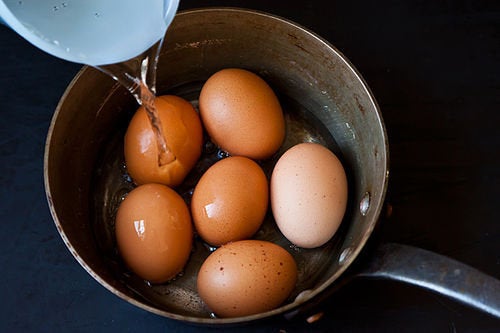
Inspired by conversations on the Food52 Hotline, we're sharing tips and tricks that make navigating all of our kitchens easier and more fun.
Today: Never make a rubbery egg again.
We've all had bad hard-boiled eggs. Rubbery whites, chalky yolks, sulfuric smells: they evoke painful memories of school lunches and sad buffets. But done right, they can be the perfect addition to your brown bag or a light breakfast, sprinkled simply with salt and pepper.
Successfully boiling an egg is quite simple, really -- all you need is a pot of water and a timer, and you're on your way to creamy yolks and glistening whites. We've found that the easiest way is the best way, and it just requires a few steps.
First things first: the freshest eggs aren't best for boiling -- they're difficult to peel. If you get your eggs from a local farm, use week-old eggs. If you're buying from a regular grocer, boil away -- they've likely had a few days of rest on the shelf.
Place your eggs in a pot with enough cold water to cover them by about one inch. Heat your pot on high, uncovered and then turn off your heat just a second before your water reaches a boil. Cover your pot immediately and let the eggs sit for six to 10 minutes. Make sure to set a timer here -- an extra minute of cooking time can make a big difference.
The yolk spectrum: eggs taken out at six minutes, eight minutes, and 12 minutes.
After your chosen number of minutes have passed, run your eggs under cold water until they are cool to the touch. Alternately, you can transfer your eggs to a bowl filled with ice water. Cooling your eggs quickly will keep them from overcooking and save you from that unsettling (but harmless!) green ring that can form around the yolk.
Set the bowl aside until the eggs cool completely, or peel immediately for instant gratification.
Remember to be gentle when peeling your eggs -- it's easy to get aggressive, whacking them against the counter with reckless abandon. Instead, tap each egg gently on the counter all over to crack it. Roll the egg between your hands to loosen the shell, and then peel, starting at the large end. Peeling your egg while holding it under cold water will make the process easier and wash off any stray shell fragments. Finally, enjoy the fruits of your labor: bite right in, brown bag an egg salad sandwich, or whip up genius deviled eggs.
Want to get even more scientific about your egg-boiling strategy? This post from the Serious Eats Food Lab is the most comprehensive resource for hard boiling eggs you'll find. And if you're not a fan of the hard boil, try mastering the art of frying, poaching, or sunny-side-upping. Your breakfast will thank you.